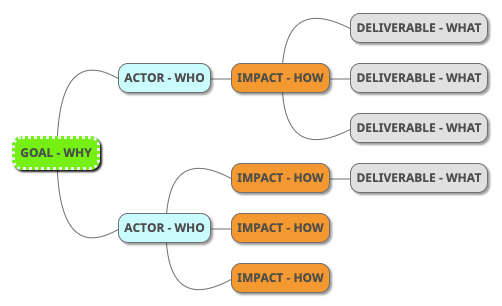Impact mapping is a versatile tool that should be in every PM's pocket. You can apply impact mapping to better communicate, collaborate and eventually reach better results for your product and organisation.
What is impact mapping?
Impact mapping is a lightweight, collaborative planning technique for teams that want to make a big impact with software products. It is based on user interaction design, outcome driven planning and mind mapping. Impact maps help delivery teams and stakeholders visualise roadmaps, explain how deliverables connect to user needs, and communicate how user outcomes relate to higher level organisational goals.
How does an impact map look?
Why would you use impact mapping?
In this short series, I'd like to suggest several ways you can utilise impact mapping to increase your chances of achieving product success. We will start from the most obvious ones and then explore some creative ways to use impact mapping in product management.Collaboration
The first and most obvious use of impact mapping is to collaboratively plan your product development. Some might call it requirements gathering, some might say roadmapping... Either way, the essence of using impact mapping for planning is to answer the following questions: why do we want to do something, who do we want to act and how? And lastly - what will we do exactly to achieve our goals?The main benefit of using impact mapping for this vital part of any product development process is that it is a collaborative and highly visual technique. The impact map clearly shows how your planned outputs might lead to the outcomes you want and eventually to reaching your goals. The impact map promotes healthy discussions on different ways to reach the same outcomes.
Communication
Impact mapping could be a powerful alignment tool for the entire organisation and could help you uncover the disconnect between the goals different stakeholders might have. Communicating your plans in an impact map format might help your stakeholders to understand better how things you plan to do (outputs) will contribute to the desired outcomes and eventually lead to reaching the goals your organisation has set.You might get feedback about the impact map you've shared with alternative views or novel ideas on outputs or actors you need to consider. Eventually, you could reach a state when the entire organisation thinks in an "impact" way which is a major step on the path of developing a product mindset.
Career
A less obvious way to use impact mapping for PMs is to advance their careers. You can use this technique to set your career goals, identify actors that could help you reach them, deduct outcomes you will need to produce and finally ideate on actions (outputs) you might try on the way.As with other applications, it would be a good idea to do career impact mapping together with someone. Ideally, it would be your mentor or just a more experienced PM that you want to learn from. They can offer you insights into every part of the impact map and spark vital considerations that could affect or change completely your goals.
A living artefact
No matter the purpose, when you use impact mapping be sure to update it often with the insights you're getting while working towards your goals. It's a good practice to do regular retrospectives and add relevant learnings to the impact map.For example, you might add the results of the recent usability study and modify the planned output accordingly. Or you can add a new actor to your map when the new competitor enters the market.
A good impact map is clear and obvious for your entire organisation and serves as a unifying communication and learning tool.
In the coming series of posts, I'd dive deeper into some of the applications of the impact map to suggest how it could be useful for product managers.

